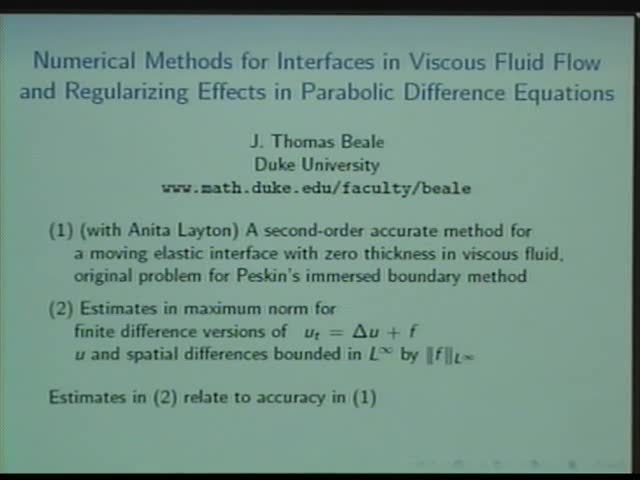Numerical methods for interfaces and regularizing effects in difference equations
Presenter
February 25, 2010
Keywords:
- Difference equations
MSC:
- 65Q10
Abstract
Keywords: Navier-Stokes flow, Stokes flow, boundary integral,
stiff equations, fractional stepping, immersed interface,
immersed boundary, semigroups of operators,
finite difference methods, parabolic equations, diffusion,
regularity, stability, L-stable, A-stable, maximum norm
Abstract: We will discuss two related projects. Work with A. Layton has the goal
of designing a second-order accurate numerical method for viscous fluid
flow with a moving elastic interface with zero thickness, the original
problem for which Peskin introduced the immersed boundary method. We
will discuss some of the background for such numerical
methods. In our approach, we decompose the velocity in
the Navier-Stokes equations at each time into a part determined by the
(equilibrium) Stokes equations, with the interfacial force, and a
"regular" remainder which can be calculated without special treatment
at the interface. For the "Stokes" part we use the immersed interface
method or boundary integrals; for the regular part we use the
semi-Lagrangian method to
advance in time. Simple test problems indicate second-order accuracy
despite a first-order truncation error near the interface, as has come
to be expected with certain interfacial methods. We will describe
analytical results which partially justify this expectation. For a
fully discrete parabolic equation, we have proved a
regularizing effect: If we solve a nonhomogeneous heat equation with a
finite difference method, with L-stable temporal discretization, using
large time steps, then the solution and its first differences are
bounded uniformly by the maximum of the nonhomogeneity, and the second
differences are almost bounded. The proof uses the point of view of
analytic semigroups of operators.
